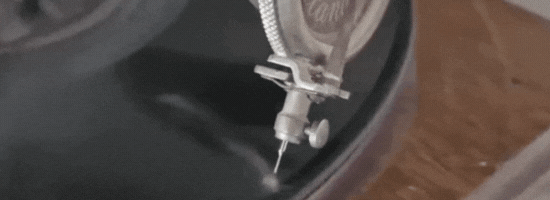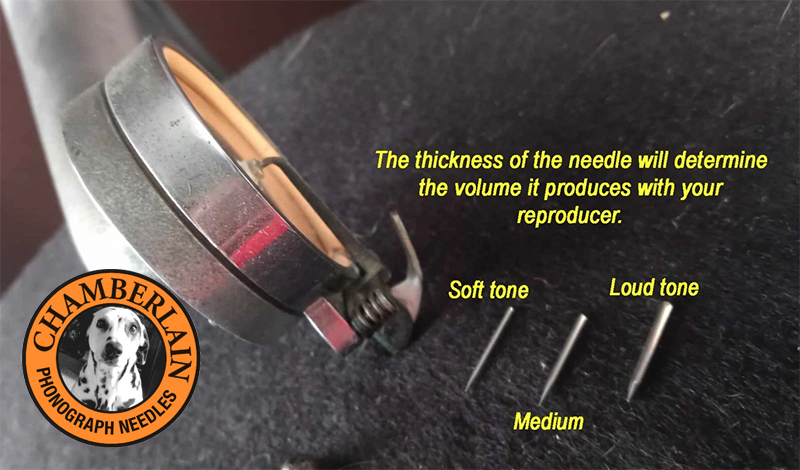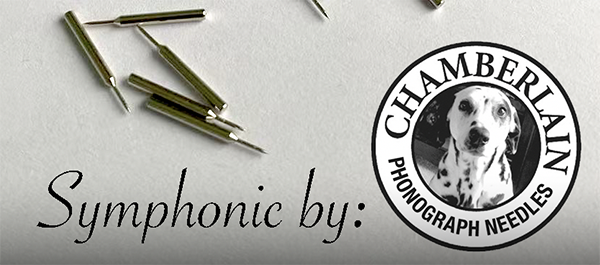
Questions & Answers / Intro 101
Answering some of the most common questions.
![]()
______ • ______
Most popular question:
Do I to need to replace the needle after every play of the record?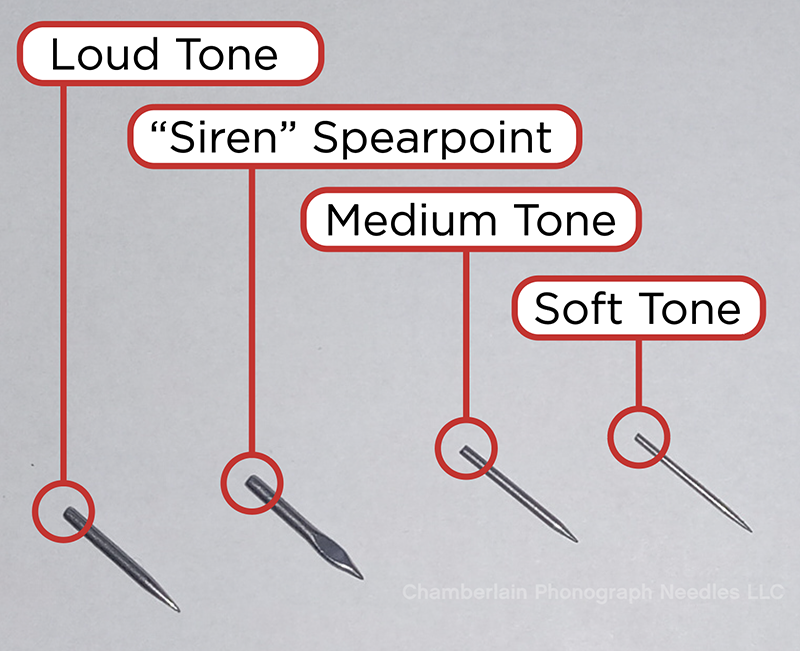
YES. The needle tip is meant to get worn down during the play of the record, it is ADVISED to REPLACE the needle after every play of a song to help keep the record grooves in good shape. The grooves of the record are rigged and bumpy, and file away at the metal tip and make the needle tip dull. Using a dull or used needle can chew away at the grooves of the record, making it unplayable and sounding aweful. The needle is meant to take the brunt of the force as it is being dragged and bounce around in the record grooves.
This isn't a ploy to sell more needles. This is a fact and not replacing them will shorten the life of your records. So be aware that there is no such thing as a MULTI-Play needle. I advise everyone to use a needle once and discard. Replace after every play of a song (2-3minutes). This is why I try and keep my prices low so you can afford and enjoy your historic music for more decades.
______ • ______
Dull needles can actually cause minor damage that adds up over time. Eventually, your record will be stripped bare to the point that it's not good at all. You can choose to play your vintage music only rarely or to use a needle that will minimize the damage but not give a historically accurate sound. In terms of longevity, the best choice is to have a digital recording made for you to listen to and then you should keep the records and cylinders for display.
Symphonic - A unique shape that has the tip of a soft tone, but the shaft thickness of the Loud tone needle. I recommend these on Berliner & Zonophone records from 1890s. Medium tone - They're exactly like they're described Spearpoint - Almost looks like a fountain pen nib with the Loud tone - Using these antique phonograph needles allows you to hear DO NOT USE OLD WORN NEEDLES; RUSTED OR USED! |
______ • ______
I have an Edison phonograph, will steel needles work?
No. Edison machines used their own technology and the reproducer was fitted with a diamond-tip stylus that was not meant to be replaced, unless broken or stolen. Photo donated by Wyatt Markus.
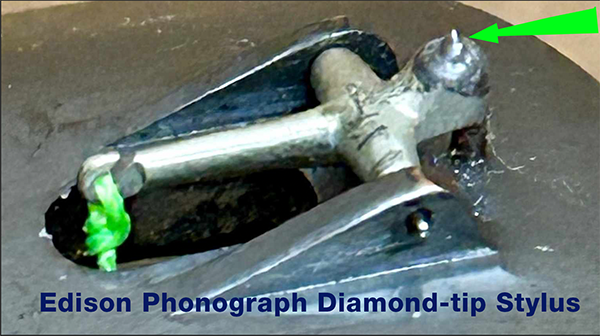
The Edison phonograph was able to play standard shellac records using a special tone-arm adapter that held a standard reproducer that used a metal needle. These are in collectors hands, so they are hard to find now days. The thick 1/4" records called Diamond Disc records by Edison are meant to be played using his Diamond-tip stylus mounted on his branded reproducer. Many third party manufacturers sold the adapter for Edison machines. See below for several adapters shown.
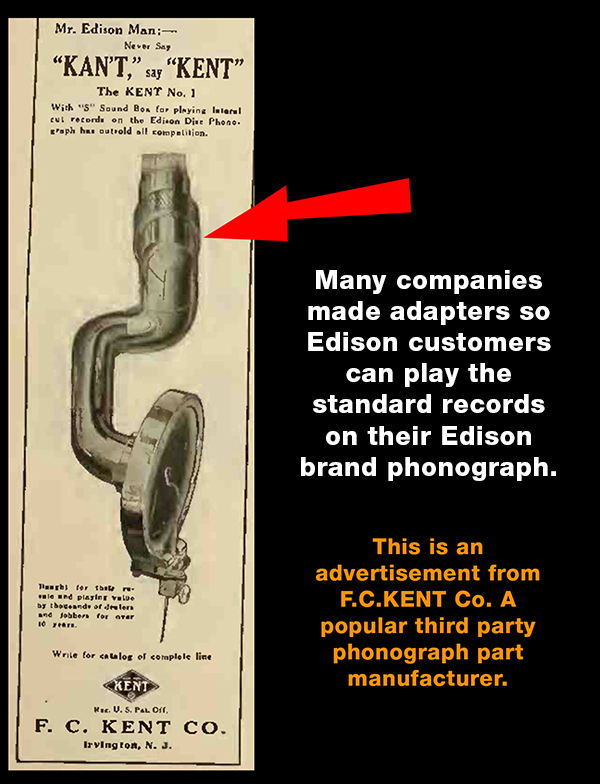
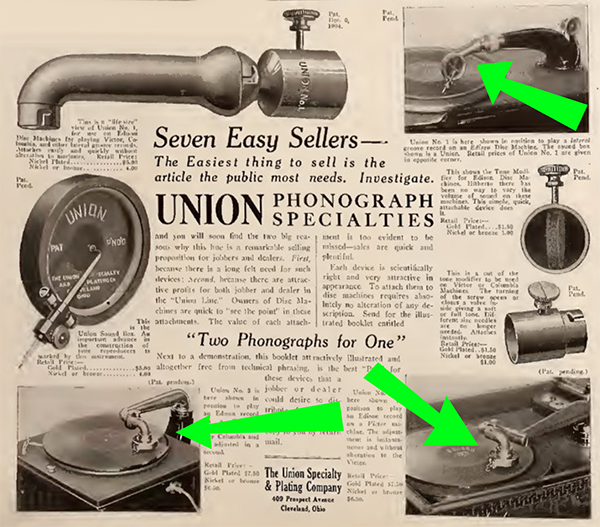
______ • ______
What are some of the Phonograph brands that used steel Needles?
Victor, Columbia, Brunswick, Sonata, Sonora, Silvertone were just a few...
Right Click onto the Photo below and save to your desktop, to see the list, not all of the brands are listed.

______ • ______
Why is there a triangle in the Reproducer hole?
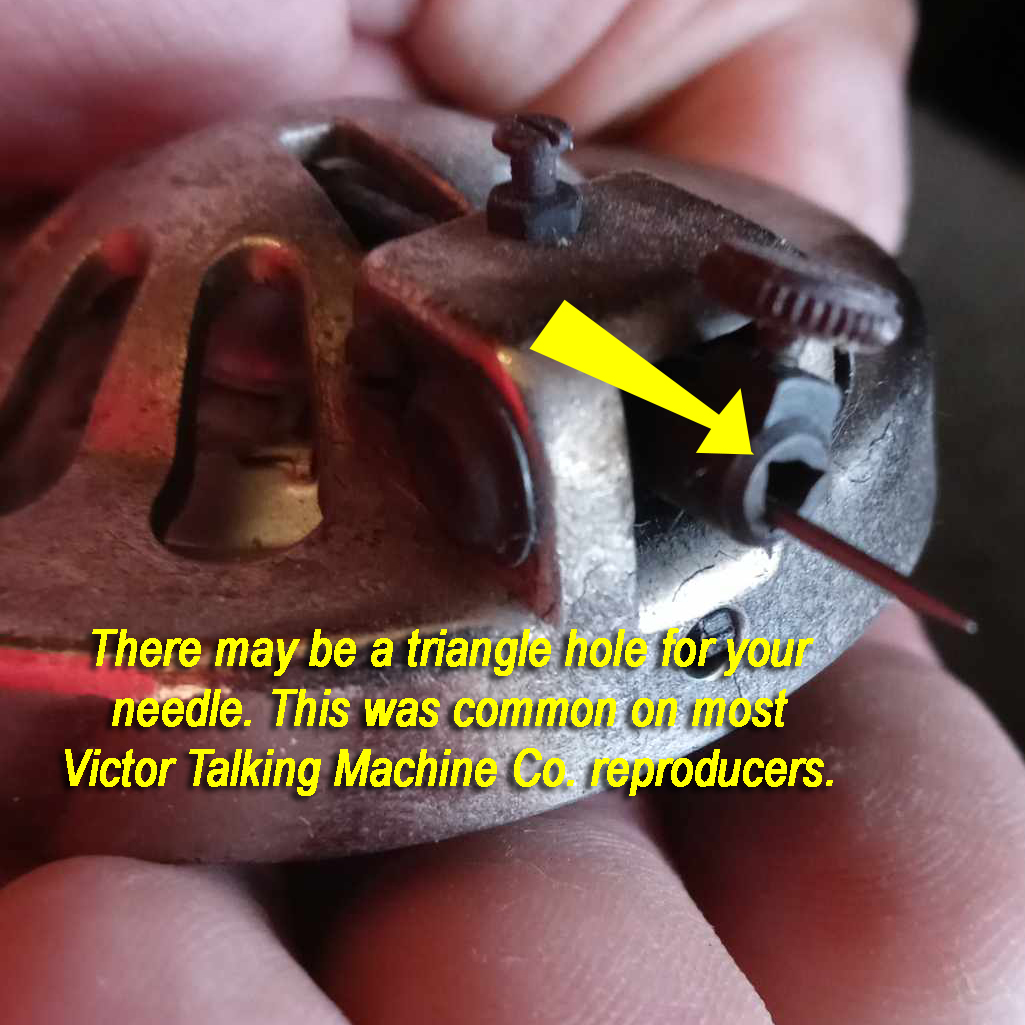
If your reproducer has this triangle shape, this was meant so you can use the triangle shaped Fibre/Bamboo needle that were available back in the early 1900s. Some people liked to use them and these have to be shaved after every play to keep them sharp. Not worth the time or effort in my opinion when steel needles are affordable and sound better.
______ • ______
Where does the tone arm go? What direction is correct?
Placing the needle so that it is "pushed" into the spinning grooves can cause damage. Please be sure the needle is being dragged, on the right side of the record as shown.
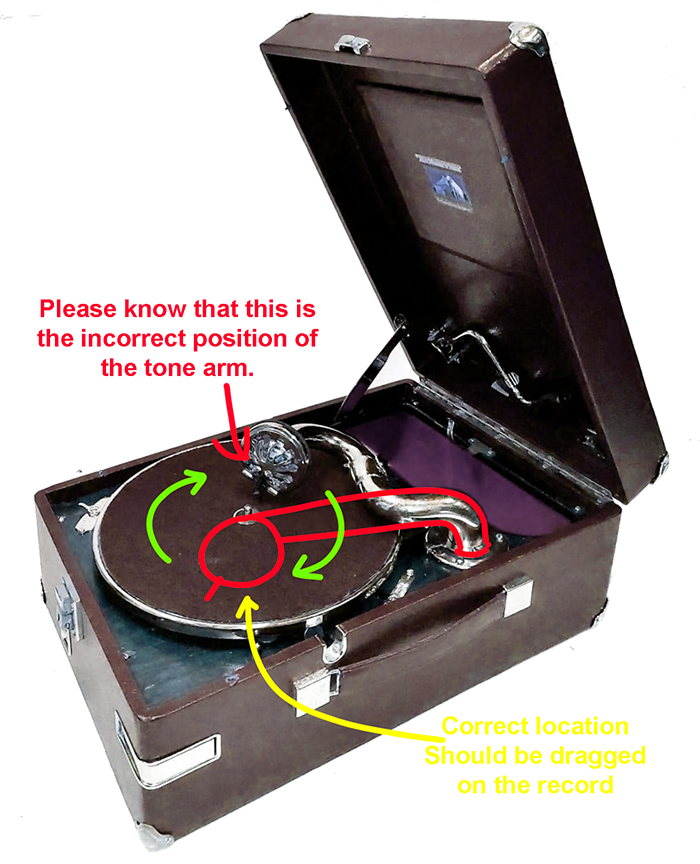
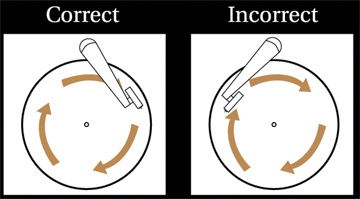
______ • ______
I push the needle into the reproducer and it's too short?
Don't shove the needle all the way into the hole of your reproducer. It should fit just enough into the hole so your thumbscrew can tighten onto it and hold it into place securely. You should have a lot of needle sticking out.
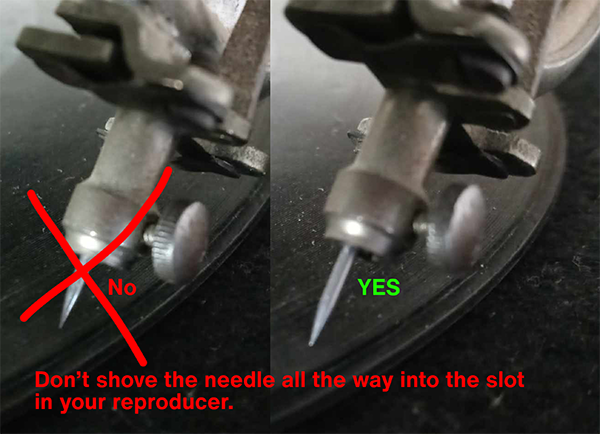
______ • ______
The needle won't stay in the Reproducer after
I tighten the Thumscrew all the way?
There's a good chance your thumbscrew was either broken or replaced by the incorrect thumbscrew with too short of a threaded shaft to hold the needle into place. Sometimes these get cracked, stolen or lost and then replaced by the Phonograph seller by using one they find in the common screw section of your local home store. If it's not squeezing the needle into place, you may need to find an actual replacement that works in your reproducer that will hold the needle into proper postion.
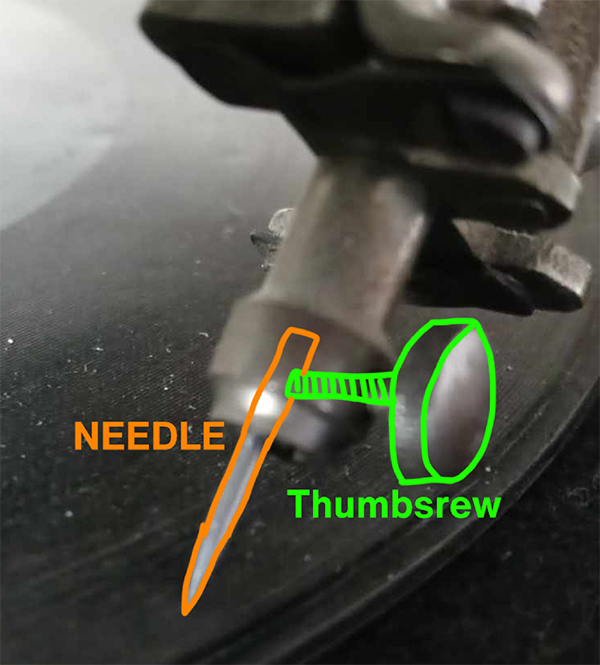
______ • ______
I have a Brunswick, will the needles work?
Yes, the Brunswick reproducer was made to use several different stylus' depending on the spin and angle of the needle location. You will see it has different spaces and angles to use different stylus on different types of records.
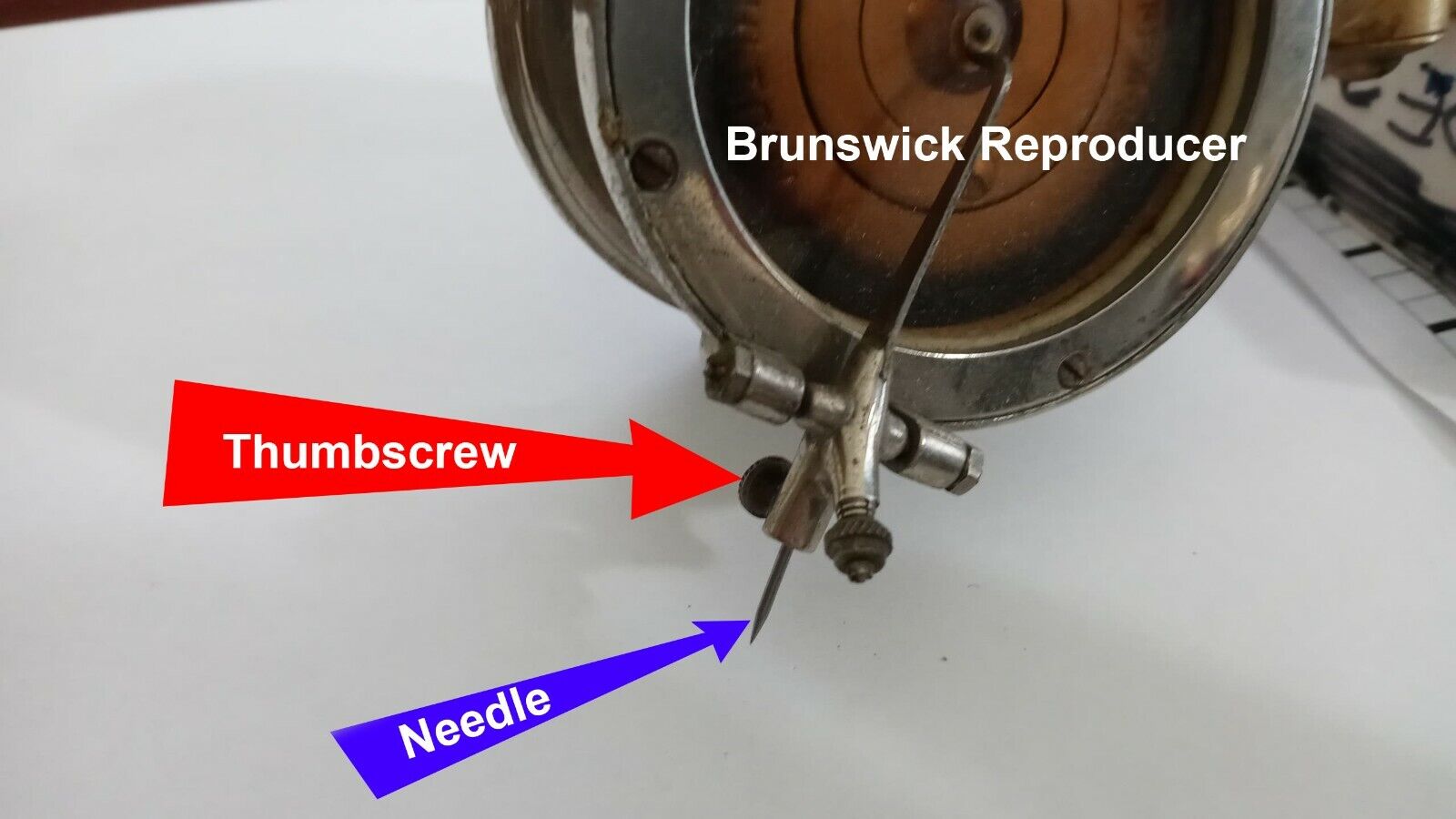
______ • ______
I have a Columbia Phonograph, with a spring action lever to hold the needle, will the needles work?
Yes, the Columbia reproducer with the spring action lever will hold all of these needles into place. If it doesn't, then you will need to have your reproducer fixed so that the lever is working properly. When the lever is working properly, it should hold all of the needles into place not matter what tone you use. It can probably use a good cleaning, and/or a new spring so the tension is correct on it, if it is not holding the skinnier soft tone needles in place.
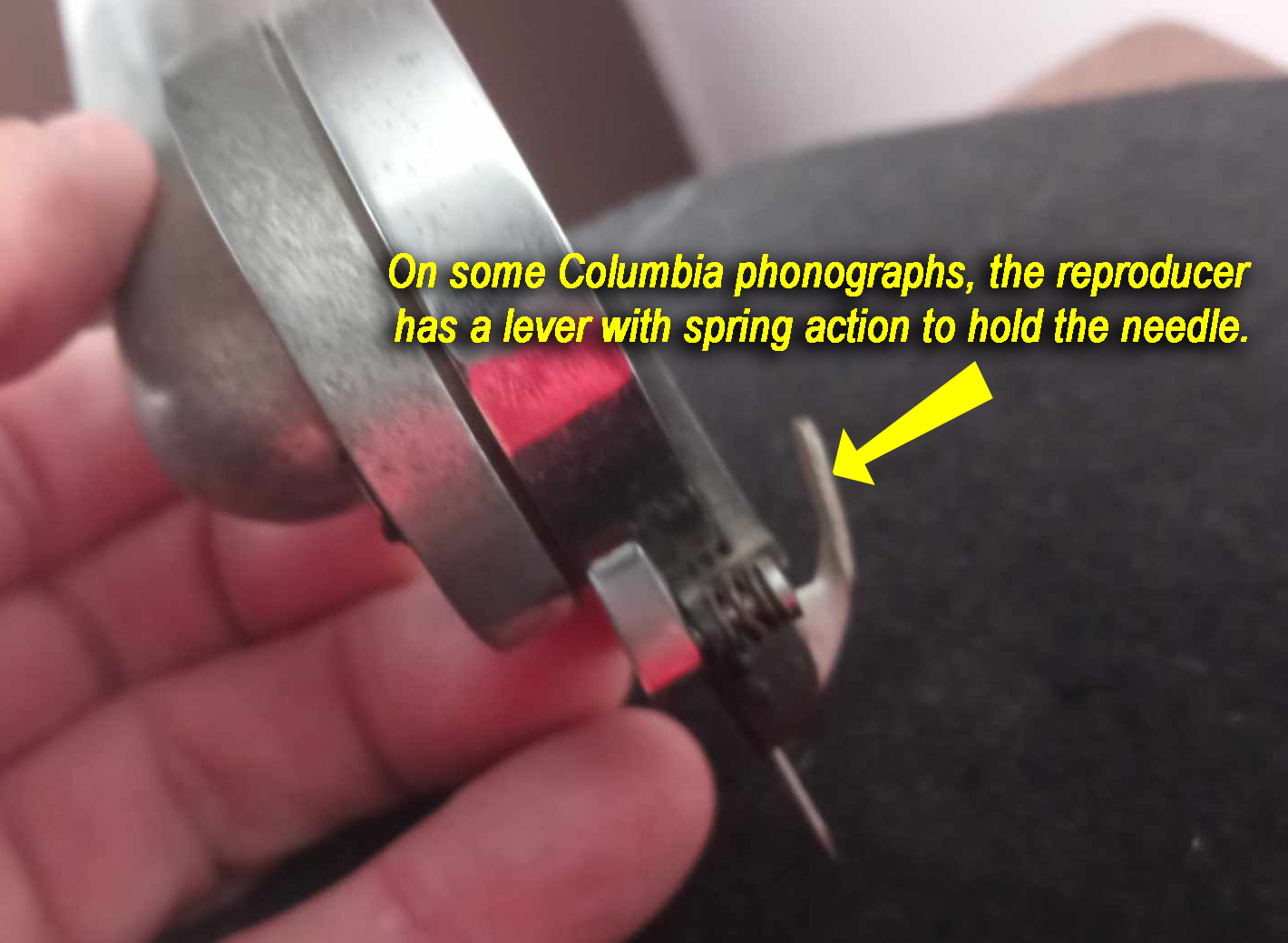
______ • ______
Why does my record stop spinning when I place the needle on it?
The very first thing that comes to mind is that your mainspring is either broken, cracked or gunked up with old solidified sticky grease. You will need to have it looked at by a phonograph technician that specializes in repairing old phonographs or you can do this yourself. The main reason it stops is because there is not enough tension on the spring after being wound up. If your phonograph has two springs, and one is broken, it's only getting half the power it needs to rotate the turntable plate. There are several videos on Youtube on how to replace the old grease. This is a very messy job.
______ • ______
Will my Sonora/Silvertone/Sonata/Columbia,
play records using your needle?
Yes! As long as your machine has a reproducer that holds the needle into place using the thumbscrew mechanism. Needles were used by many manufacturers of the era. Literally thousands!!! Please be sure the record you want to play is meant to be played using the steel needle on the antique phonograph. Do not play incorrect records with a steel needle. See next question.
______ • ______
Why does my Elvis and my Disco albums sound bad?
Please make sure you are playing the correct type of record for your antique phonograph. Plastic albums from 1950s to current time are not supposed to be played using a metal needle. The substate of your Abba album is made of plastic, much softer than the Shellac records that were produced in 1890 to 1930s. You should not be playing modern records on your old victrola. They will be destroyed by the metal needle.
______ • ______
Who invented the flat disc record?
Emile Berliner (May 20, 1851 – August 3, 1929) was a German-American inventor. He is best known for inventing the lateral-cut flat disc record used with a gramophone. He founded the United States Gramophone Company in 1894. His records were one sided and featured one song.
______ • ______
Who invented the double sided flat disc record?
Columbia Record Company released the first double sided record during the summer of 1908. By September of 1908, Columbia was converting its entire catalog to “double-discs,” recorded on both sides. This revolutionized the record standard as other companies had to adopt this method to keep up in sales revenue.
______ • ______
Who is "Victrola"? Where did the monkier come from?
The Victor "Victrola" was born in the early 1900s and the word "VICTROLA" was registered with the United States Patent and Trademark Office in 1906 and still current to this day and used by RCA/Sony Music Entertainment. In 1929, the Radio Corporation of America (RCA) purchased the Victor Talking Machine Company, then the world's largest manufacturer of phonographs, record catalogs and Artists signed under their label. Below is a image of one of the original "Victrola" from Victor Talking Machine Co.
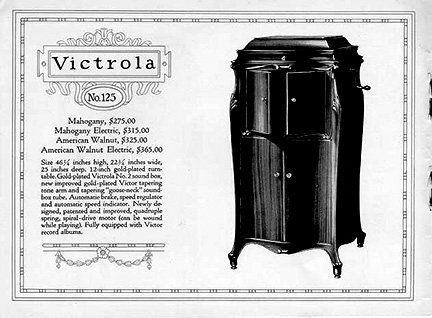
Today, there are many small companies using the generic word "VICTROLA" to sell things such as coffee beans, coffee shops, small electronics, modern electric toy record players, and other various items, that have no relation or significance to the original "VICTROLA" from Victor Talking Machine Co. and RCA.These small company's logos may and can be registered with the USPTO, therefore, protected from any use. But the words; Victrola, Phonograph, Gramophone, are all public domain and part of the English language dictionary, for everyday use.
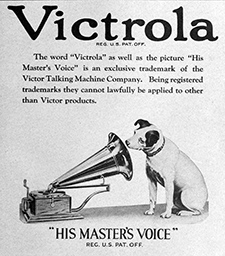
People can and do use the moniker "VICTROLA" when they are refering to an antique phonograph that's made of wood, usually hand crank, with the speaker inside the cabinet. The word, Gramophone, is a British word, usually refering to the Phonograph too and used to describe these and Outside Horned phonographs. Either way, Victrola, Gramophone and Phonograph all are used today when talking about Antique phonographs from the early 1900s.
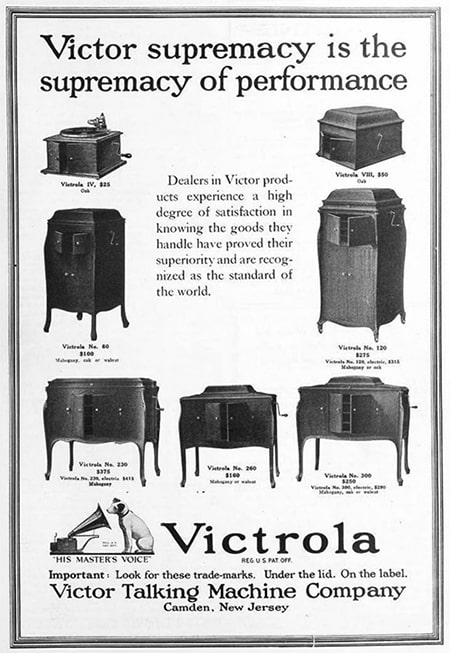
This advertising sign below is from late 1930s and showing one of the electric record players from RCA. It had an electric pickup and used a special stylus to play its records.
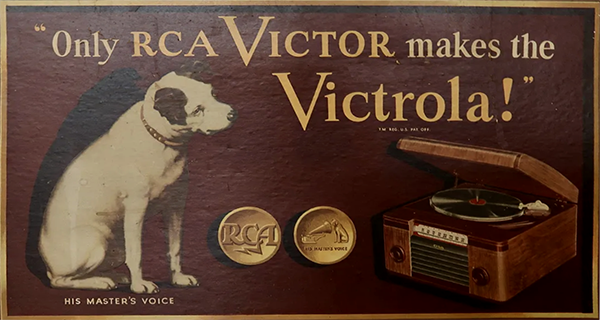
______ • ______
What volume does the Needles produce?
Each needle will create a soft to loud volume when used. Soft Tone are the thinnest. Loud is the thickest shaft available. Volume is a personal preference thing.
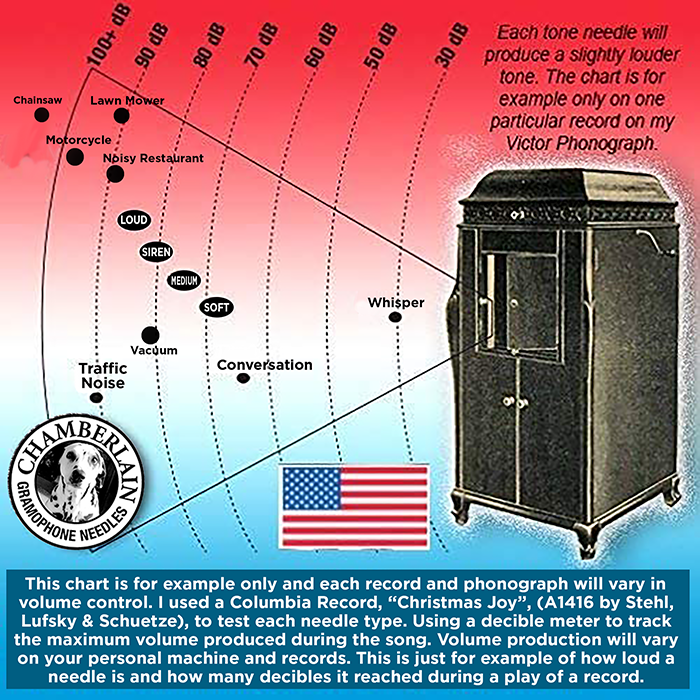
______ • ______
Will the needle work on my phonograph?
As long as your hand crank phonograph Reproducer/Sound Box has a small thumbscrew to hold them into place, they will work. Sometimes this is missing or the threaded shaft is not long enough, so there is no way for the needle to stay in place. NEVER use metal needles on VINYL OR PLASTIC records!!!
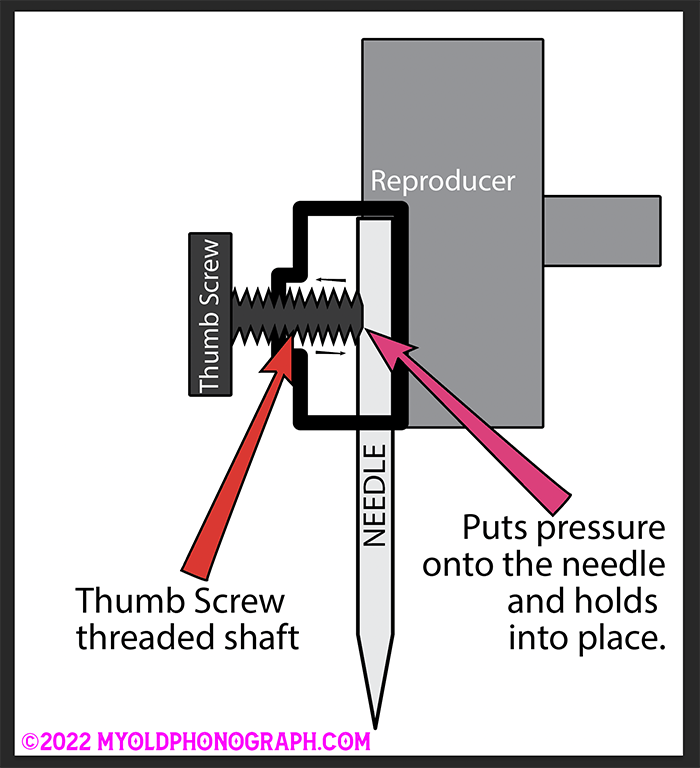
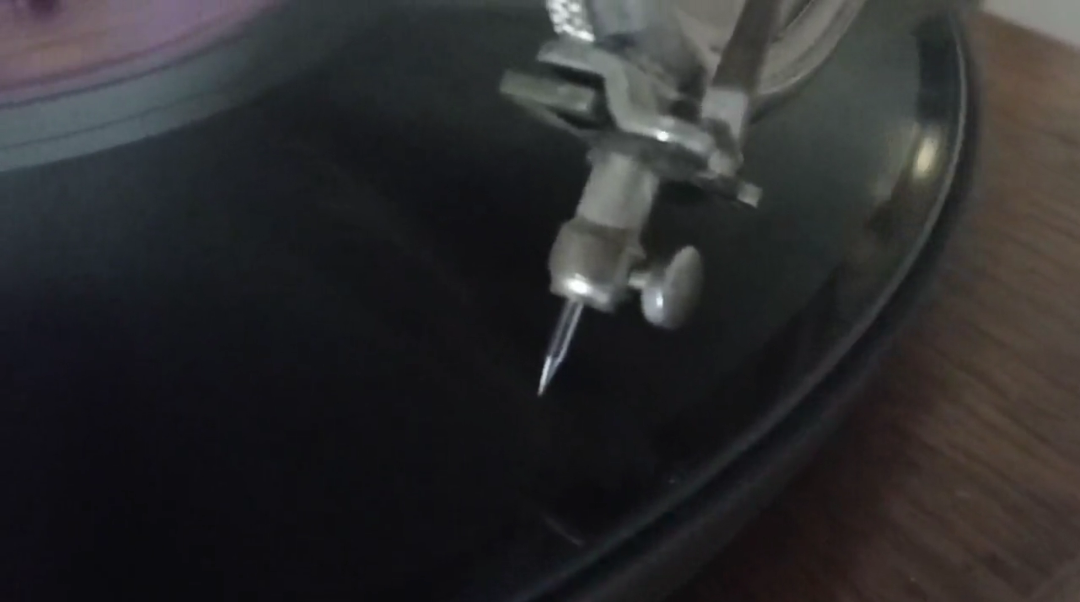
______ • ______
What Records can I play using the metal needle?
DO NOT PLAY EDISON Diamond Disc RECORDS WITH A STEEL NEEDLE!
Metal Needles are meant for the hard Shellac records from 1890s to 1930s. Anything after the 1930s may have been produced of a different substrate (depending on the company at the time) and often too soft for the metal needle. Be certain you are playing the correct record on your Gramophones.
Therefore, if you are playing a record from the 1940s, you have a possibility of ruining the record as these were most likely meant for a electrical pickup phonograph stylus. Do not play any record albums from 1950, 1960 and so on using a metal needle! So some of those big-band and jazz records you have from the 1940s are most likely meant to be played on a electric pickup phonograph! Be aware and play at your own risk on these later discs. Please educate yourself about these old phonographs.
Some of the more common brands you can play using the metal needle is Victor and Columbia from the early era. These records were made of a very hard Shellac and not plastic like the later 12 inch albums. Please know what year your record is from before using a metal needle on your wind-up old phonograph.
DO NOT play Edison Diamond Discs (Re-Creation) and Pathé records with a metal needle as these are meant for special stylus made for that particular phonograph and record made by Edison and Pathe. Do not play Edison cylinders with a metal needle too.
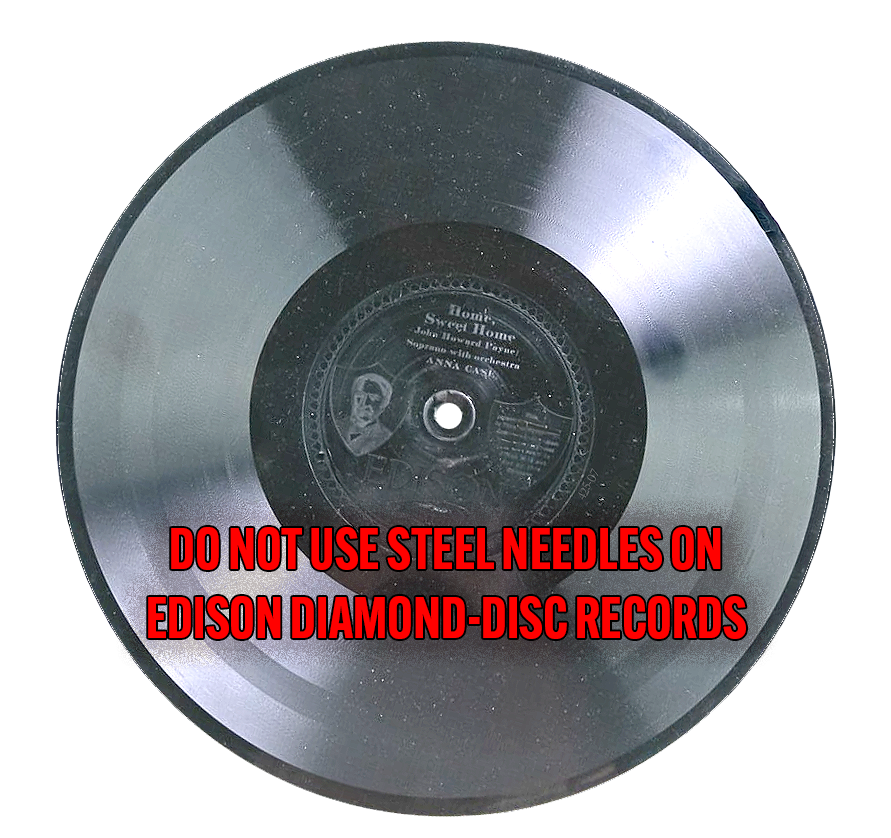
______ • ______
I have a antique Victor Victrola from the 1920's.
Can I use metal needles on it?
If you are a proud owner of the original vintage Victor Victrola and have the Reproducer that holds the needle into place, then YES, these will work for you and your shellac records. Below is the logo of the Victor Victrola, that is usually on the underside of the wooden cabinet lid. Click onto the link for Types of Phonographs to see more Victor Phonographs.
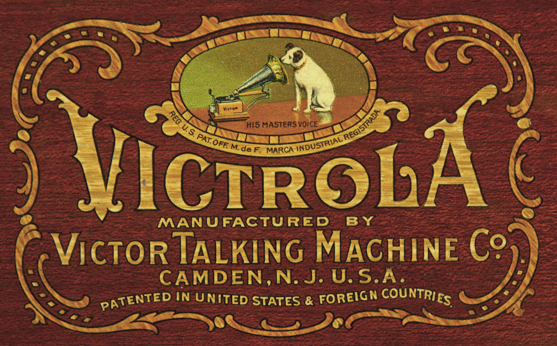
______ • ______
Can I use metal needles on my Edison Diamond Disc records? NO!!!
NO! You can't use metal needles on your Edison phonograph with the Edison reproducer. Edison made his own special records, called Edison Diamond Discs, that were meant to be played with his own special reproducer, that had a diamond tip stylus. Playing any other brand of record with this reproducer will destroy them. Below is the record labels of the Edison discs, Embossed or paper.
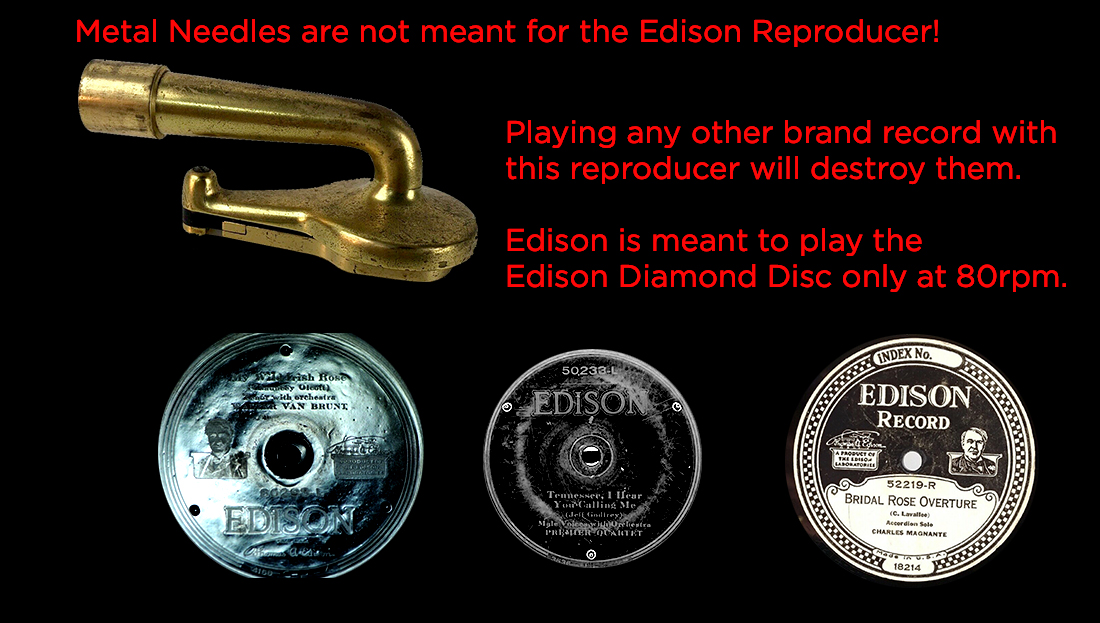
The only way you can play the standard style 78rpm records such as Victor, Columbia, etc. with the Edison phonograph is to get a special adaptor that has the correct reproducer on the end, that uses the metal needle for those particular flat discs.
For more Edison Phonograph information, Click the photo above or click here
______ • ______
I just bought this new modern toy record player,
will your needles work on it?
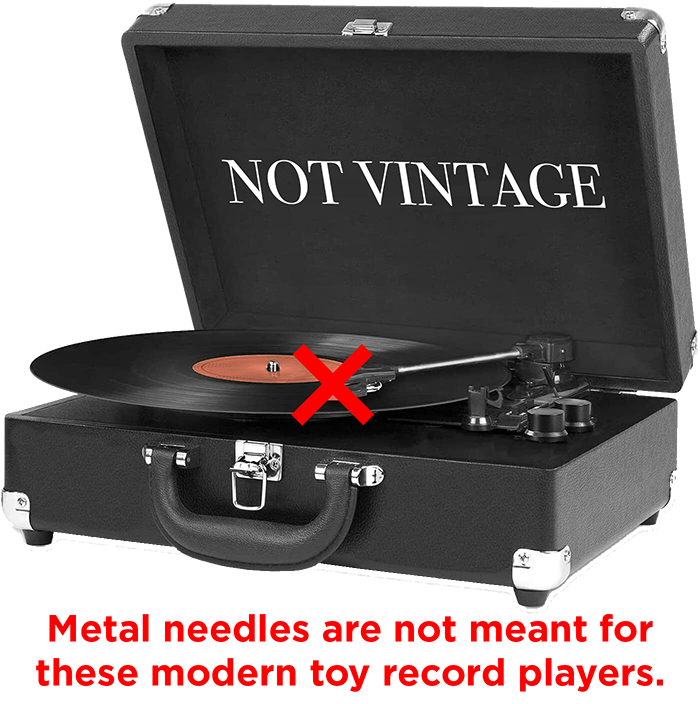
NO! These new toy record players you see being sold today use a special plastic electric pick-up stylus. Metal needles are meant for antique Victor Victrolas, Columbia Graphaphones, and hand-crank Gramophones from the early 1900s that require a metal needle to play the shellac records of that era.
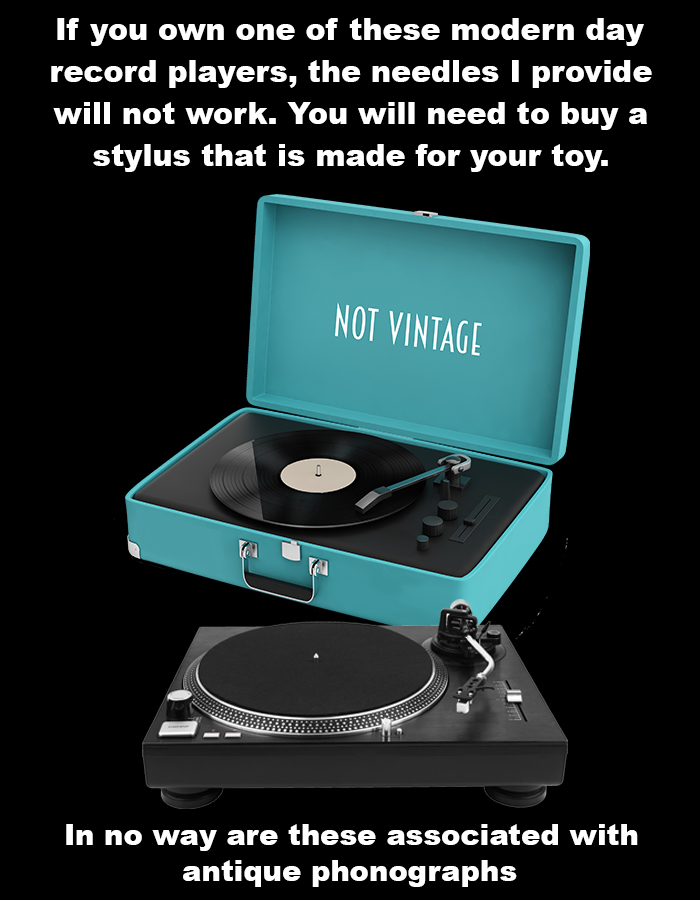
______ • ______
How to clean your old 78rpm disc records
Things You'll Need: • Mild hand dishwashing detergent • Soft washcloth or soft bristle paintbrush
• Lint-free cloth • Distilled water
1. Rinse the 78 rpm record with water, taking care not to get the label wet.
2. Mix a few drops of dishwashing soap (Dawn) (a mild type) with water. Apply to the record using a clean, soft cloth (shammy) or a small clean soft bristle paintbrush. Wipe the record in the direction of the grooves, never across the grooves. Use light pressure to remove stubborn dirt spots. Never use Rubbing Alcohol or Alcohol based products such as Windx on your records.
3. Rinse the record again in water to remove the detergent solution, again taking care not the wet the label.
4. If your tap water is hard and tends to leave spots on your dishes, follow it with a rinse of distilled water. If your dishes have spots, good chance your records will too. Use distilled water rather than your tap water.
5. Dry the clean 78 rpm record by dabbing it with a clean, lint-free shammy cloth. Do not wipe across the grooves. Let sit flat on dry towel for at least 12-16 hours so that they dry before playing on your phonograph. Do not try to speed drying by placing under a hairdryer, microwave or oven.
______ • ______
I hear a thump when I crank up my phonograph?
When you crank up the phonograph, a thump occurs. This can be a number of things. But the most common reason is that the lubrication grease inside the spring housing is getting dry and the spring is sticking. The only way to remedy this is to have the motor cleaned and the springs regreased. Leaving it as it is will eventually ruin the springs, possibly breaking them. Below is a photo of a typical Spring in a Phonograph.
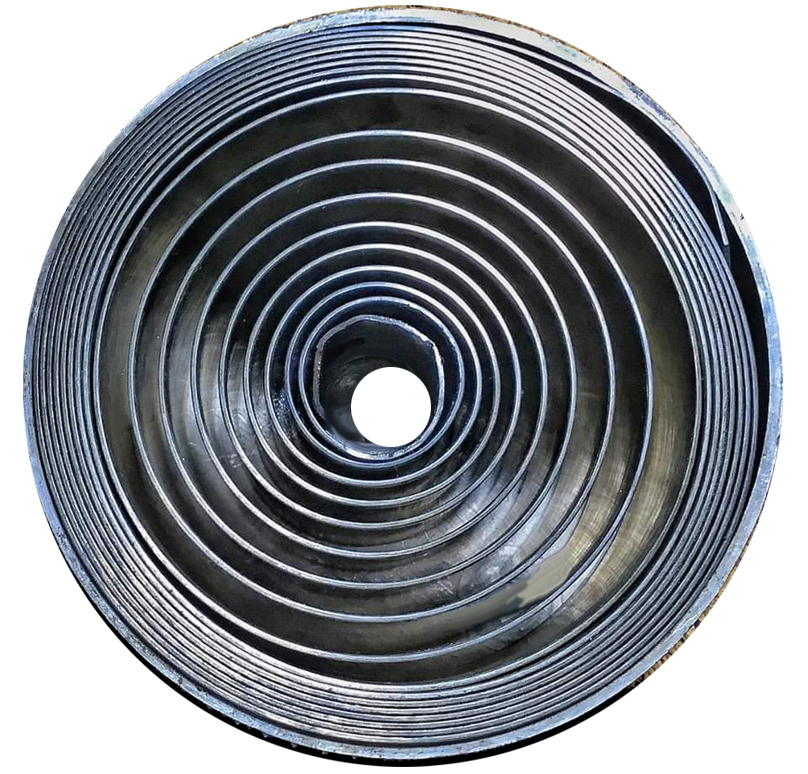
______ • ______
There's no tension when I crank my phonograph?
This is most likely due to either cracked springs or springs that released from the pin within the barrel housing case. The springs within the case will have to be removed, cleaned, fixed/replaced and regreased. See the next question.
______ • ______
I want my broken phonograph fixed. Who do I call?
There are several repair services across the nation and you can find these via Google search.
I do not fix phonographs.
______ • ______
I need a small part to fix my own phonograph
(Micas, gaskets, springs, felt, screws, and more)
There are several repair services and parts sellers across the nation and you can find these via Google search. I no longer sell parts unless I find something special.
______ • ______
I see "New Old Stock" on some sales listings,
What does that mean?
New Old Stock (NOS) really means, "I have something that is old and never used". This is a fancy way to say, "Buy it cuz it's old and pay more money for it". In my eyes, NOS is just a way to get people to buy something readily available for more money. I don't advise using OLD needles even if they look unused.
New needles are affordable enough and you know you're getting brand new.
______ • ______
Can I play common 78rpm discs on my
Edison and Pathé Phonograph?
Edison and Pathé (Pronounced, Pah-tay), are the only records that use a special stylus that lasts much longer than the standard metal needle. These were constructed of either a Sapphire or Diamond tip.
Edison used the Diamond stylus and was made to play its Diamond Disc records. These are not meant to be replaced after every play of a edison record.
Pathé use a Sapphire stylus and were made to play Pathé discs at 90rpm. These are not meant to be replaced unless cracked or missing.
Using these two different stylus on your old shellac records can damage them instantly. Never use a metal needle on Edison or Pathé records. The only Pathé record that actually uses a metal needle are called "Actualle" made by Pathé.
______ • ______
What is the needle/stylus for my Edison?
Edison decided to use his own technology and his own style of records. He called his records, Diamond Discs. You can identify these records from other 78's because they are about 1/4 inch thick. They also will have Edison's face embossed or on the label too.
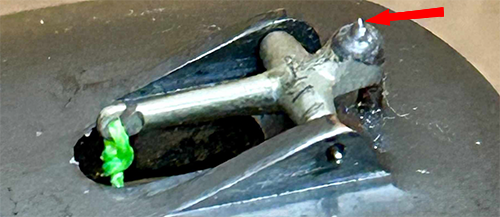
The Edison phonograph stylus was meant to play thousands of records without replacing. The stylus was made of Diamond tip. These were not meant to be switched out like the common metal needles. These are still available although may need to be replaced by a professional repair service. They can also get more spendy.
______ • ______
What the heck is a Pathé Needle/stylus?
Early Pathé records were made to use the Sapphire Stylus, which looked like a glass ball at the end of a metal shaft. These were meant only for Pathé records that spun at 90rpm. This stylus lasted a longer period time if taken care of and for many plays of records. Using this on the standard 78rpm records can ruin them. Pathé eventually stopped production of their special "Vertical" Cut records and created the record called "Actuelle" that used the metal needle and spun at 78rpm. Some Pathe phonographs can fit and use metal needles but you need to only play the correct records that required the metal needle on your Pathe phonograph. Please educate yourself before doing this.
______ • ______
I need new needles for my phonograph, where do I go?
Since 1991, You can buy them from the original needle source, right here.
Cut out the middleman, save yourself time and money.
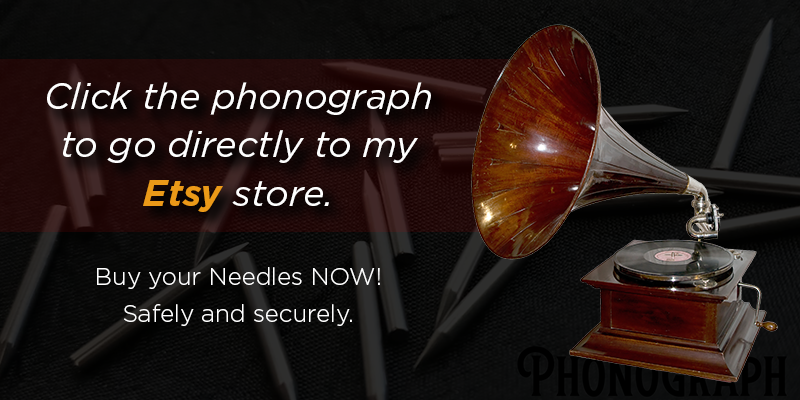
______ • ______
Disclaimer: If you are new to the hobby of antique phonographs, Please educate yourself and know what type of records should be played using the steel needle. Some records and reissues from the late 1940s, 1950s to current times can be and most likely produced of a softer substrate such as plastic. Therefore, steel needles are not recommended as the surface of the record may be too soft. Records from the 1900-1940s were made of Shellac, a harder substrate meant for these steel needles.
The production of shellac records continued throughout the 78 rpm era, which lasted until 1948 in industrialized nations.
PLEASE EDUCATE YOURSELF before using any steel needle on any record you intend to play. There are many websites explaining the technology and how records were made during this era.
Do not play EDISON Diamond-Disc records using steel needles!
© 2025 MyOldPhonograph.com

